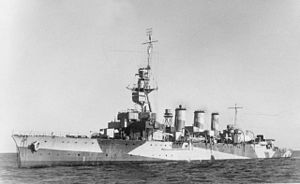HMAS Adelaide (1918)

HMAS Adelaide in her third armament configuration
|
|
| History | |
|---|---|
|
|
|
| Namesake: | City of Adelaide |
| Builder: | Cockatoo Island Dockyard |
| Laid down: | 20 November 1915 |
| Launched: | 27 July 1918 |
| Completed: | 31 July 1922 |
| Commissioned: | 5 August 1922 |
| Decommissioned: | 27 June 1928 |
| Recommissioned: | 13 March 1939 |
| Decommissioned: | 17 May 1939 |
| Recommissioned: | 1 September 1939 |
| Decommissioned: | 26 February 1945 |
| Recommissioned: | 19 May 1945 |
| Decommissioned: | 13 May 1946 |
| Motto: |
|
| Nickname(s): | HMAS Longdelayed |
| Honours and awards: |
|
| Fate: | Sold for scrap |
| General characteristics | |
| Class and type: | Town-class light cruiser |
| Displacement: | 5,560 tons |
| Length: | 138.8 m (455 ft) |
| Beam: | 14.9 m (49 ft) |
| Draught: | 5.7 m (19 ft) |
| Propulsion: | Parsons turbines, 2 shafts, 25,000 shp (19,000 kW) |
| Speed: | 25 knots (46.3 km/h; 28.8 mph) |
| Complement: |
|
| Armament: |
|
| Armour: | 3-inch (7.6 cm) side armour-belt over midships section |
HMAS Adelaide was a Town-class light cruiser of the Royal Australian Navy (RAN), named after Adelaide, the capital city of South Australia. Laid down in 1915, wartime shortages and design modifications meant the ship was not completed until 1922, earning her the nickname "HMAS Longdelayed".
Adelaide served with the Royal Navy's Special Service Squadron during 1924 and 1925, and was involved in the 1927 Malaita massacre. She was decommissioned in 1928, but was modernised and returned to service just before World War II began. During the war, Adelaide was involved in successful efforts to secure the colony of New Caledonia for Free France, was present during the Japanese midget submarine attack on Sydney Harbour, and intercepted the German blockade runner Ramses.
The cruiser was decommissioned in 1946, and broken up for scrap in 1949.
The design of Adelaide was modified from the Chatham subclass of the Town-class light cruisers, with similarities to the Birmingham subclass. The ship was 462 feet 6.5 inches (140.983 m) long overall and 430 feet (130 m) between perpendiculars, with a beam of 49 feet 9.5 inches (15.177 m), and a draught of 19.66 feet (5.99 m). The initial ship's company stood at 33 officers and 450 sailors, but by 1941, this had dropped to 26 officers and 436 sailors.
The propulsion system consisted of Parsons turbines providing 25,000 shaft horsepower (19,000 kW) to two propeller shafts. As designed, the ship had a maximum speed of 25 knots (46 km/h; 29 mph), but modifications during her career saw this increase to 25.5 knots (47.2 km/h; 29.3 mph) during the 1920s, then drop to 24.8 knots (45.9 km/h; 28.5 mph) by 1941. The cruiser was originally fuelled by both coal and oil, but the ship's refit in 1938–39 saw her converted to oil only, along with the removal of the foremost funnel and boilers.
...
Wikipedia
